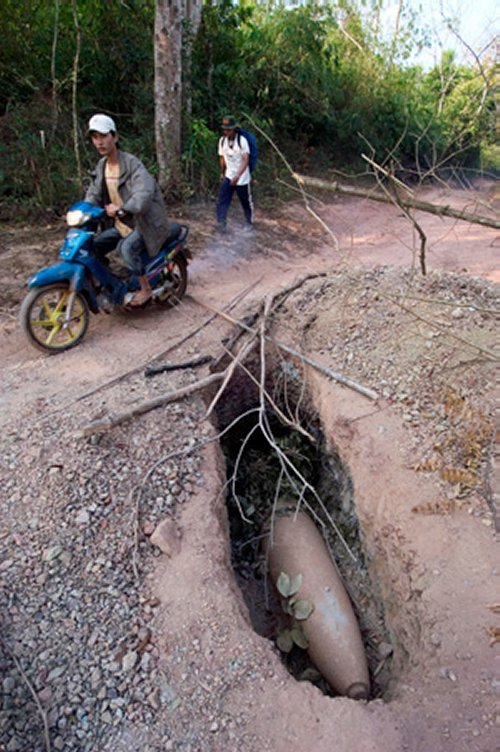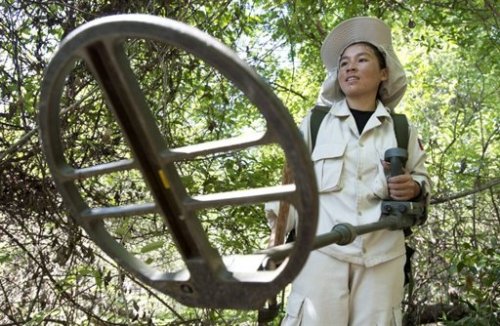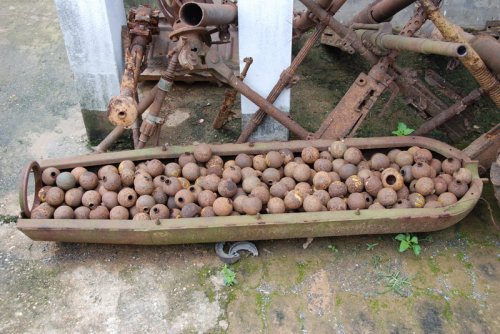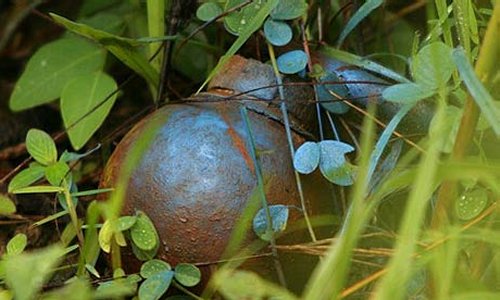Young Laotians Look Ahead As They Help Clear Deadly Remains Of Vietnam War
Shadowed by a dense green and brown jungle canopy, Phakhai Keo methodically guides her metal detector across a thick carpet of grass, leaf and vine until a loud squeal cuts the still of the forest like a machete.
She has found a deadly remnant of a war that ended long before she was born — and she couldn’t be happier. “The day we find nothing is not so fulfilling,” says the 25-year-old, who has spent the last three months combing the jungles and fields of southern Laos for unexploded cluster munitions.
Phakhai is part of a six-person team of deminers from Norwegian People’s Aid (NPA), one of the handful of international organizations working to relieve Laos of its dubious status as the country most contaminated by cluster bombs.
Four decades after it ended, the Vietnam War is still killing and maiming people in this largely forgotten neighbouring land. And it is falling to the post-war generation of young people like Phakhai to finally halt the carnage.
Laos marked 40 years this past spring since the last bombs were dropped in a covert nine-year bombing campaign that saw American warplanes dump two million tonnes of bombs on a country then populated by two million people.
Many Laotian people want to forgive their attackers, forget the pain of the past and move forward, but with unexploded cluster munitions in 14 of the country’s 17 provinces, they are prisoners of their dark history.
The secret U.S. bombing campaign was an attempt to crush communist North Vietnamese forces using the Ho Chi Minh trail, the historic supply network that partly wound through the southern Laos countryside where Phakhai and her colleagues now toil.
About 80 million cluster bombs — baseball-sized submunitions — failed to explode after American B-52s dropped 270 million of them from 1964 to 1973. About 20,000 people have been injured, killed or maimed by bombs since the war ended.
Atle Karlsen, head of NPA in Laos, said a lot of formal clearance has already taken place, as well as a lot of informal work by scrap-metal dealers and farmers, who had no choice but to clear land to feed their families. But a staggering problem remains.
“That means that Laos probably can be cleared in 10, 20, 50 years instead of 200, 500 years,” Karlsen said. Unexploded ordnance, known as UXO, is the main obstacle to development — to building roads, schools, clinics and markets.
Marknownay village, population 207, offers proof of the challenges. Its 36 stark wooden structures balanced on stilts, encircle an open green space dotted with trees and stands of bamboo that stretch as tall as five storeys. Cattle, pigs and dogs scavenge the ground.
On the periphery, a hollowed out, 122mm mortar shell hanging from the porch of a one-room wooden schoolhouse serves as loud and sturdy bell.
Under a broad, leafy mango tree, the central meeting and shade point of the village, 47-year-old Thidsone (he uses only one name) draws a circle in the sand with a stick and bisects it to illustrate his problem.
This is his farmland, he says, all two hectares of it and he can’t use half of it. He’s been farming around cluster bombs without incident for 22 years. Last year, when the roving task force from NPA arrived in the village, he gave them access to half of his rice paddy.
They found 100 cluster bombs. They put them all in a big hole and blew them up, which is what NPA does in this area once they’ve found a critical mass of ordnance. None of this stops Thidsone from going into his field to plant every year. “We have no choice,” he says. “We are poor. If we don’t plant in our area, we cannot do anything. How can we survive?”
Nearby Marknowngai village, population 630, shows the same circular layout of dwellings, roaming livestock, ubiquitous central mango tree and the lurking, lethal threat.
 Noiyai, who also uses only one name, was a teenager during the bombing, which he says was particularly intense in 1970 and 1971. “I remember people go to the riverbank and another plane drops on the river and we move again,” the 58-year-old says.
Noiyai, who also uses only one name, was a teenager during the bombing, which he says was particularly intense in 1970 and 1971. “I remember people go to the riverbank and another plane drops on the river and we move again,” the 58-year-old says.
Ask Noiyai about his attitude toward his country’s American attackers and his answer is typical of what many of the Laotian people say these days. “If we view the things of the past, the Americans are not good,” he said. “But now it is no problem because the Americans help us do the cleaning. “The war has ended. There is no more war, so we forgive.”
Thirty-five years after the war ended, Phongsavath Manithong was walking to school in the small central Laotian village of Vinegthong when a friend retrieved a small metal bulb from the side of the road and handed it to him. He tried to pry it open and it exploded. Phongsavath lost his sight and both hands. It was Feb. 12, 2008, his 16th birthday.
“We are not angry to the American government,” he says today, five years after his life-altering accident. “Many American people, they did not know what happened in Laos. But we need help. We need more help from the American government. They are a rich country. … That’s not enough to help the disabled people, the survivors.”
Twenty-three years after the last bombs fell, eight-year-old Thoummy Silamphan was out digging for bamboo shoots to help feed his family. His spade hit a metal object and it exploded. The blast ripped Silamphan’s left hand apart. When he awoke the next morning in a hospital, he tried to wash his hands. He couldn’t. His left one was gone.
“That was a traumatic experience,” says the now dapper 24-year-old, a day after returning to Laos from a multi-city tour of the United States with fellow bomb victims to raise awareness — and money — for the rehabilitation of young survivors.
“The Vietnam War ended many, many years ago and they thought everything was good in Laos,” he said. “After I share my story and what problem we have, many, many people are interested to help and support.”
The United States is the largest international donor to the Laos UXO sector, contributing almost half of the $20 million spent here annually by foreign countries. Canada, which contributed more than $2 million between 1996 and 2011, has stopped funding the sector, prompting the Laos government to ask it to resume helping. So far, Ottawa hasn’t responded.
Karen Stewart, the U.S. ambassador to Laos, says she finds it surprising and heartening to encounter the no-hard-feelings attitude toward her country expressed by so many Laotian people.
“Like many Americans, I think anyone regrets that the leftovers of war are still hurting,” she said in an interview in her official residence. “You can’t help but regret that and to want to fix it. “I think it’s for the best that we all focus on the future and work together rather than continue to look back.”
Phongsavath is focused firmly on the future. He spends his days telling his story to tourists and backpackers who come to a small museum in Vientiane, the capital, where he explains the ravages of cluster bombs. He stays in touch with friends using a flip cell phone that he manipulates with his stumps. He has a voice recognition feature on his laptop that enables him to write and Skype.
Before his accident, he used to play a bit of guitar and drums. These days, he’s back into music. He’s performed an evocative breakdance in public that depicts his struggle to overcome hardship. He’s written a couple of songs and beats out the rhythm and melody that he hears in his head for friends.
“One of my songs is a love song — love and very, very flirting,” he says.
Source: By Mike Blanchfield, The Canadian Press




